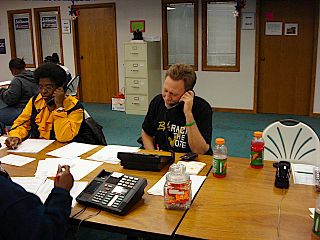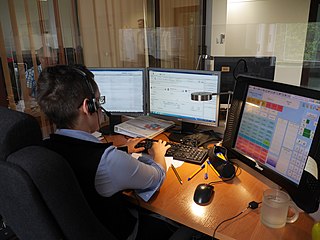Related Research Articles

A call centre or call center is a managed capability that can be centralised or remote that is used for receiving or transmitting a large volume of enquiries by telephone. An inbound call centre is operated by a company to administer incoming product or service support or information enquiries from consumers. Outbound call centres are usually operated for sales purposes such as telemarketing, for solicitation of charitable or political donations, debt collection, market research, emergency notifications, and urgent/critical needs blood banks. A contact centre is a further extension to call centres telephony based capabilities, administers centralised handling of individual communications, including letters, faxes, live support software, social media, instant message, and email.
An automated call distribution system, commonly known as automatic call distributor or automatic call dispatcher (ACD), is a telephony device that answers and distributes incoming calls to a specific group of terminals or agents within an organization. ACDs direct calls based on parameters that may include the caller's telephone number, the number they dialed, the time of day or a response to an automated voice prompt. Advanced ACD systems may use digital technologies such as Computer telephony integration (CTI), computer-supported telecommunications applications (CSTA) or IVR as input to determine the route to a person or voice announcement that will serve the caller. Experts claim that "the invention of ACD technology made the concept of a call centre possible."
Direct distance dialing (DDD) is a telecommunication service feature in North America by which a caller may, without operator assistance, call any other user outside the local calling area. Direct dialing by subscribers typically requires extra digits to be dialed as prefixes to the directory telephone number of the destination. International Direct Distance Dialing (IDDD) extends the system beyond the geographic boundaries of the North American Numbering Plan (NANP).

Telemarketing is a method of direct marketing in which a salesperson solicits prospective customers to buy products, subscriptions or services, either over the phone or through a subsequent face to face or web conferencing appointment scheduled during the call. Telemarketing can also include recorded sales pitches programmed to be played over the phone via automatic dialing.
Interactive voice response (IVR) is a technology that allows telephone users to interact with a computer-operated telephone system through the use of voice and DTMF tones input with a keypad. In telecommunications, IVR allows customers to interact with a company's host system via a telephone keypad or by speech recognition, after which services can be inquired about through the IVR dialogue. IVR systems can respond with pre-recorded or dynamically generated audio to further direct users on how to proceed. IVR systems deployed in the network are sized to handle large call volumes and also used for outbound calling as IVR systems are more intelligent than many predictive dialer systems.
Computer telephony integration, also called computer–telephone integration or CTI, is a common name for any technology that allows interactions on a telephone and a computer to be coordinated. The term is predominantly used to describe desktop-based interaction for helping users be more efficient, though it can also refer to server-based functionality such as automatic call routing.
Caller identification is a telephone service, available in analog and digital telephone systems, including voice over IP (VoIP), that transmits a caller's telephone number to the called party's telephone equipment when the call is being set up. The caller ID service may include the transmission of a name associated with the calling telephone number, in a service called Calling Name Presentation (CNAM). The service was first defined in 1993 in International Telecommunication Union – Telecommunication Standardization Sector (ITU-T) Recommendation Q.731.3.
Automatic number identification (ANI) is a feature of a telecommunications network for automatically determining the origination telephone number on toll calls for billing purposes. Automatic number identification was originally created by the American Telephone and Telegraph Company (AT&T) for long distance service in the Bell System, eliminating the need for telephone operators to manually record calls.
A voicemail system is a computer-based system that allows users and subscribers to exchange personal voice messages; to select and deliver voice information; and to process transactions relating to individuals, organizations, products, and services, using an ordinary phone. The term is also used more broadly to denote any system of conveying a stored telecommunications voice messages, including using an answering machine. Most cell phone services offer voicemail as a basic feature; many corporate private branch exchanges include versatile internal voice-messaging services, and *98 vertical service code subscription is available to most individual and small business landline subscribers.
A dialer or dialler is an electronic device that is connected to a telephone line to monitor the dialed numbers and alter them to seamlessly provide services that otherwise require lengthy National or International access codes to be dialed. A dialer automatically inserts and modifies the numbers depending on the time of day, country or area code dialed, allowing the user to subscribe to the service providers who offer the best rates. For example, a dialer could be programmed to use one service provider for international calls and another for cellular calls. This process is known as prefix insertion or least cost routing. A line powered dialer does not need any external power but instead takes the power it needs from the telephone line.
In telephony, an automated attendant allows callers to be automatically transferred to an extension without the intervention of an operator/receptionist. Many AAs will also offer a simple menu system. An auto attendant may also allow a caller to reach a live operator by dialing a number, usually "0". Typically the auto attendant is included in a business's phone system such as a PBX, but some services allow businesses to use an AA without such a system. Modern AA services can route calls to mobile phones, VoIP virtual phones, other AAs/IVRs, or other locations using traditional land-line phones or voice message machines.

A public-safety answering point (PSAP), sometimes called public-safety access point, is a call center where emergency/non-emergency calls initiated by any landline, mobile or Voice Over Internet Protocol ("VOIP") subscriber is terminated. It can also happen that when 112 is dialed in then a logic is implemented by mobile or network operators to route the call to the nearest police station. It is a call center in almost all the countries including Canada and the United States responsible for answering calls to an emergency telephone number for police, firefighting, and ambulance services. Trained telephone operators are also usually responsible for dispatching these emergency services. Most PSAPs are now capable of caller location for landline calls, and many can handle mobile phone locations as well, where the mobile phone company has a handset to location system. Some can also use voice broadcasting where outgoing voice mail can be sent to many phone numbers at once, in order to alert people to a local emergency such as a chemical spill.
Direct inward dialing (DID), also called direct dial-in (DDI) in Europe and Oceania, is a telecommunication service offered by telephone companies to subscribers who operate a private branch exchange (PBX) system. The feature provides service for multiple telephone numbers over one or more analog or digital physical circuits to the PBX, and transmits the dialed telephone number to the PBX so that a PBX extension is directly accessible for an outside caller, possibly by-passing an auto-attendant.
Screen pop is a call centre term that refers to the feature of a computer telephony integration (CTI) which automatically displays customer information via a window or dialog box on an agent's computer upon answering a customer's call.

Telephone numbers in Turkey went from six (2+4) to seven digits (3+4) local phone numbers c.1988, at which time Ankara went from 41 to 4. There used to be more than 5,000 local area codes of varying lengths with correspondingly varying local number lengths.
CT Connect is a software product that allows computer applications to monitor and control telephone calls. This monitoring and control is called computer-telephone integration, or CTI. CT Connect implements CTI by providing server software that supports the CTI link protocols used by a range of telephone systems, and client software that provides an application programming interface (API) for telephony functions.
Call management is the process of designing and implementing inbound telephone call parameters, which govern the routing of these calls through a network. The process is most prominently utilized by corporations and the call centre industry and has its highest effectiveness when call logging software tools are used. Calls are routed according to the set up of calling features within the given system such as Call queues, IVR menus, Hunt groups and Recorded announcements. Call features provide a customised experience for the caller and maximize the efficiency of inbound call handling. Call management parameters can specify how calls are distributed according to an operator's skill level in relation to a call, the time and/or date of a call, the location of the caller or through automatic routing processes.

PSTN network topology is the switching network topology of a telephone network connected to the public switched telephone network (PSTN).

A telephone exchange, telephone switch, or central office is a telecommunications system used in the public switched telephone network (PSTN) or in large enterprises. It interconnects telephone subscriber lines or virtual circuits of digital systems to establish telephone calls between subscribers.
Dialogic telephony cards was a line of PC expansion cards developed in 1990s by Dialogic Inc., at the time Media & Signaling Division of Intel Corporation, for computer telephony applications. The cards are currently produced today by Sangoma Technologies Corporation.
References
- ↑ Andrew. A Practical Guide to Call Center Technology. p315. Archived 2014-06-28 at the Wayback Machine
- ↑ Encyclopedia of Information Technology. Atlantic Publishers and Distributors LTD. 2007. p. 142. ISBN 978-81-269-0752-6.